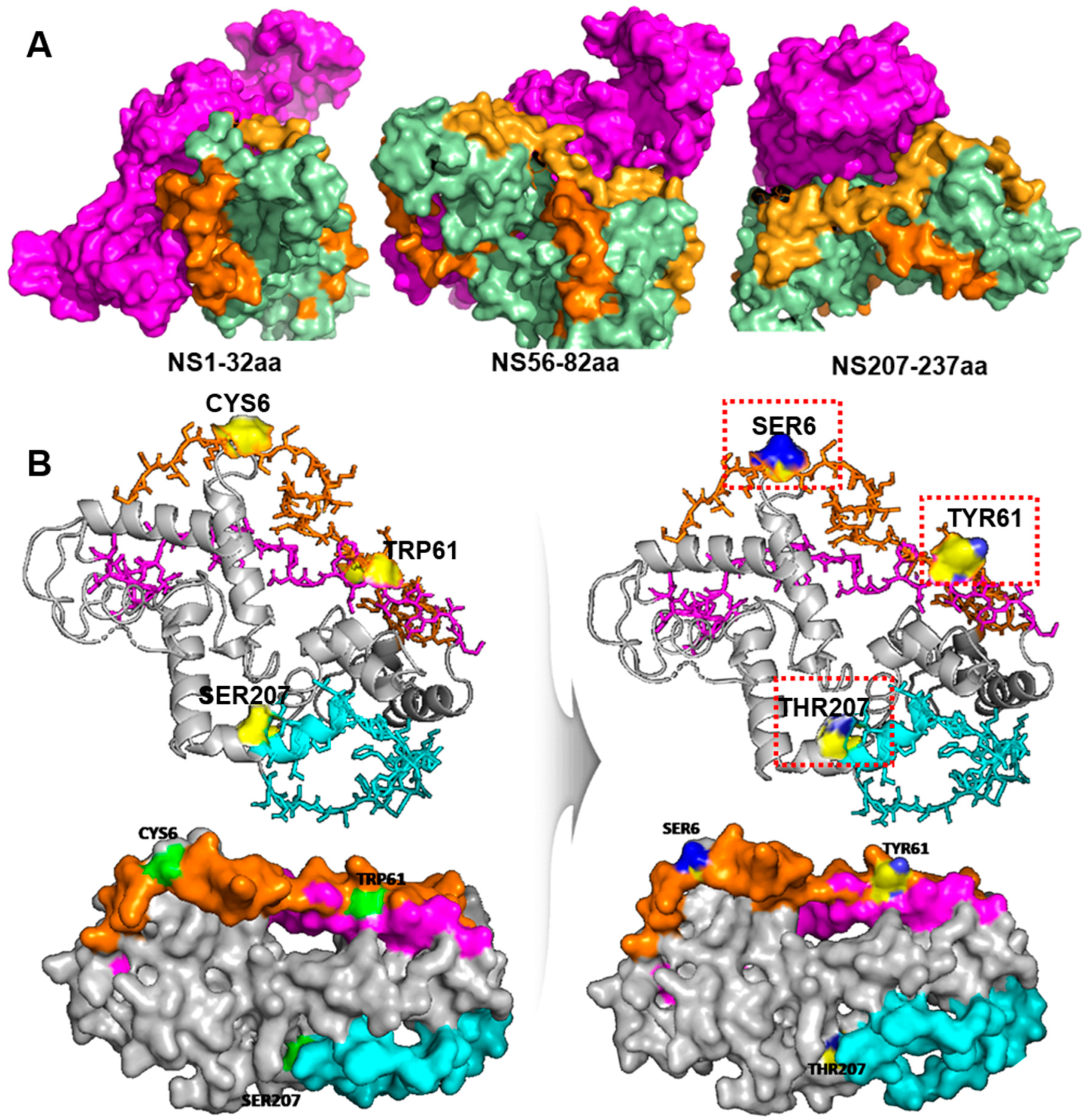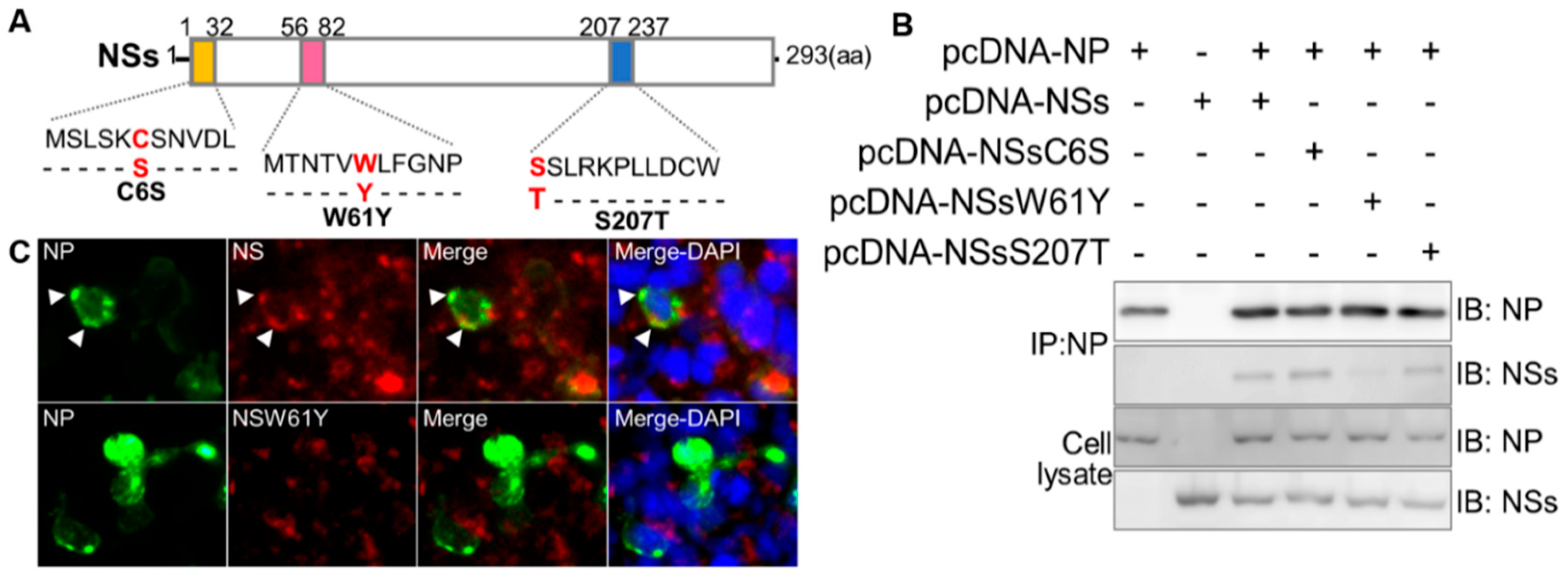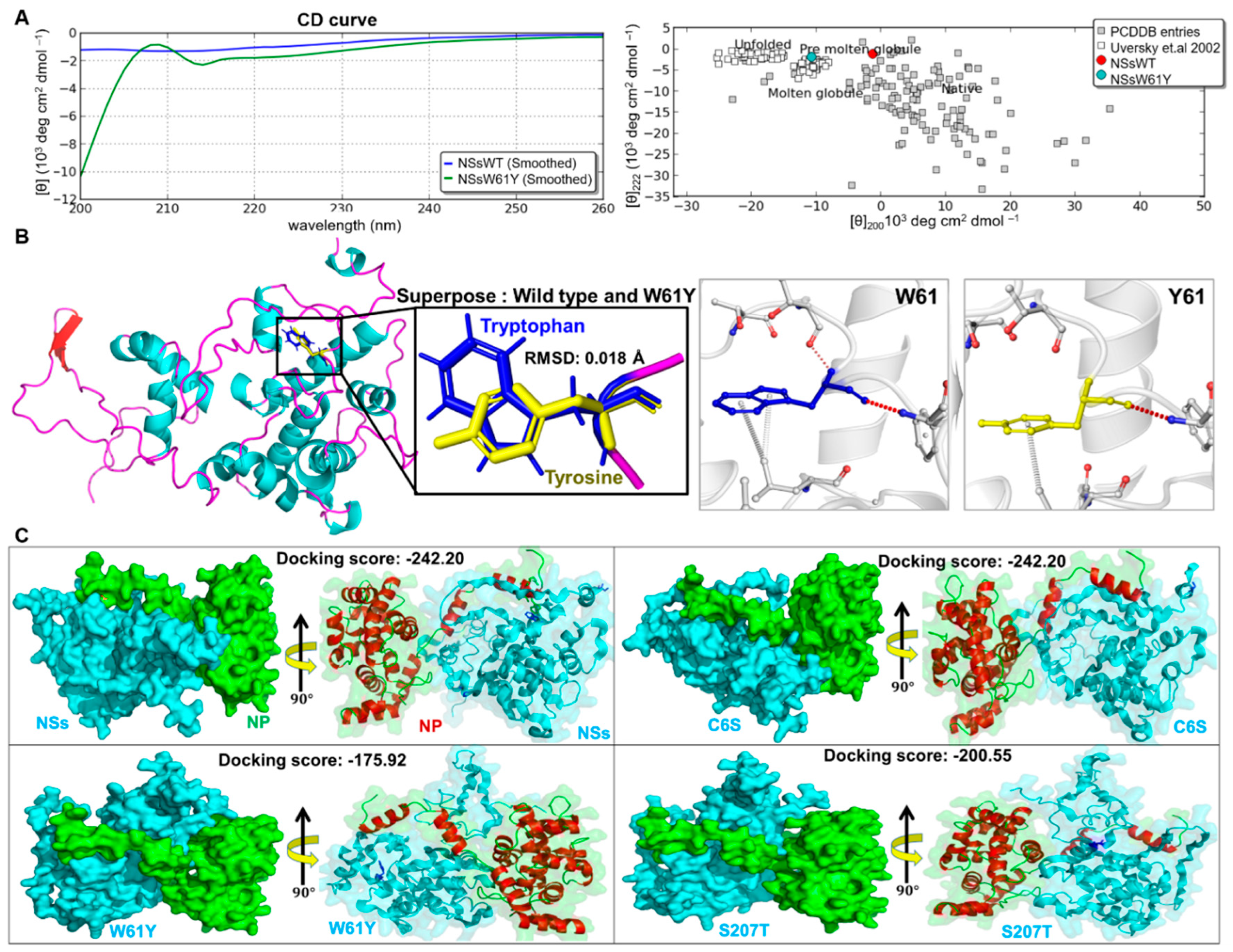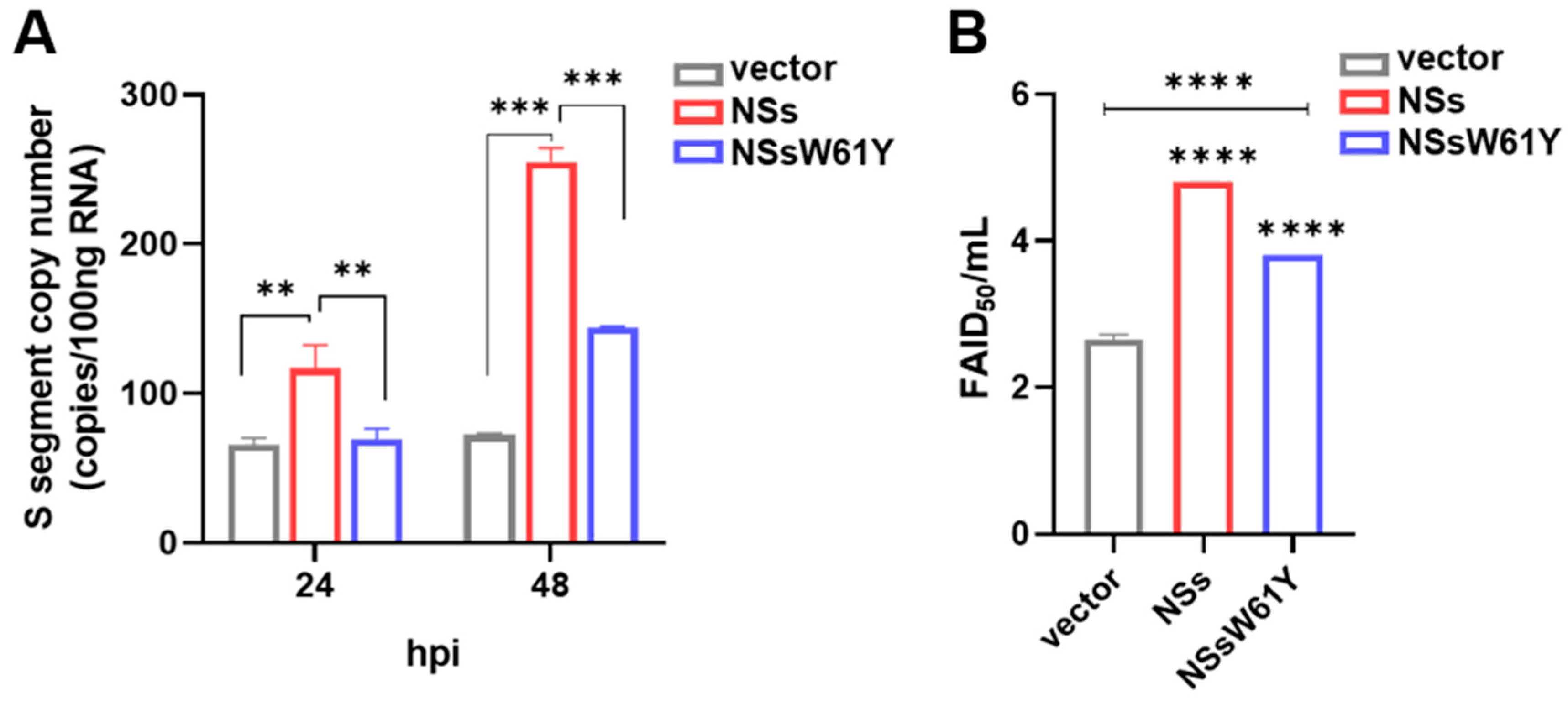Submitted:
07 August 2023
Posted:
08 August 2023
You are already at the latest version
Abstract
Keywords:
1. Introduction
2. Materials and Methods
2.1. Cell Lines and Virus
2.2. Accession Numbers
2.3. Construction of the DNA Plasmids
2.4. Protein Expression and Purification
2.5. Antibody Production
2.6. Circular Dichroism (CD) Spectroscopy
2.7. In-Silico Analysis
2.8. Immunofluorescence assay (IFA) and Fluorescence Active Infectious Dose (FAID50) Assay
2.9. Immunoprecipitation (IP) Assay
2.10. Quantitative Real-Time PCR
2.11. Statistical Analysis
3. Results
3.1. Construction Characterization of the NP, NSs, and NS Mutant Proteins
3.2. Effects of NS Mutations at Positions C6S, W61Y, and S207T on Binding to NP
3.3. Comparing NSs and NS Mutant Structures
3.4. Effects of W61Y NS Mutations on SFTSV Replication
4. Discussion
Supplementary Materials
Author Contributions
Funding
Informed Consent Statement
Data Availability Statement
Conflicts of Interest
References
- Blitvich, B.J.; Beaty, B.J.; Blair, C.D.; et al. Bunyavirus taxonomy: limitations and misconceptions associated with the current ICTV criteria used for species demarcation. The American Journal of Tropical Medicine and Hygiene 2018, 99, 11. [Google Scholar] [CrossRef] [PubMed]
- Savage, H.M.; Godsey, M.S., Jr.; Panella, N.A.; et al. Surveillance for Heartland virus (Bunyaviridae: Phlebovirus) in Missouri during 2013: first detection of virus in adults of Amblyomma americanum (Acari: Ixodidae). Journal of Medical Entomology 2016, 53, 607–12. [Google Scholar] [CrossRef]
- Savage, H.M.; Godsey, M.S., Jr.; Lambert, A.; et al. First detection of heartland virus (Bunyaviridae: Phlebovirus) from field collected arthropods. The American journal of tropical medicine and hygiene 2013, 89, 445. [Google Scholar] [CrossRef] [PubMed]
- McMullan, L.K.; Folk, S.M.; Kelly, A.J.; et al. A new phlebovirus associated with severe febrile illness in Missouri. New England Journal of Medicine 2012, 367, 834–41. [Google Scholar] [CrossRef]
- Wang, J.; Selleck, P.; Yu, M.; et al. Novel phlebovirus with zoonotic potential isolated from ticks, Australia. Emerging infectious diseases 2014, 20, 1040. [Google Scholar] [CrossRef] [PubMed]
- Mourya, D.; Yadav, P.; Basu, A.; et al. Malsoor virus, a novel bat phlebovirus, is closely related to severe fever with thrombocytopenia syndrome virus and heartland virus. Journal of virology 2014, 88, 3605–9. [Google Scholar] [CrossRef] [PubMed]
- Meng, K.; Sun, W.; Cheng, Z.; Guo, H.; Liu, J.; Chai, T. First detection of severe fever with thrombocytopenia syndrome virus in the tick species Haemaphysalis concinna in Shandong Province, China. Parasitology research 2015, 114, 4703–7. [Google Scholar] [CrossRef]
- Ning, Y.-J.; Feng, K.; Min, Y.-Q.; et al. Disruption of type I interferon signaling by the nonstructural protein of severe fever with thrombocytopenia syndrome virus via the hijacking of STAT2 and STAT1 into inclusion bodies. Journal of virology 2015, 89, 4227–36. [Google Scholar] [CrossRef]
- Wu, X.; Qi, X.; Liang, M.; et al. Roles of viroplasm-like structures formed by nonstructural protein NSs in infection with severe fever with thrombocytopenia syndrome virus. The FASEB Journal 2014, 28, 2504–16. [Google Scholar] [CrossRef]
- Sun, Y.; Li, J.; Gao, G.F.; Tien, P.; Liu, W. Bunyavirales ribonucleoproteins: the viral replication and transcription machinery. Critical reviews in microbiology 2018, 44, 522–40. [Google Scholar] [CrossRef]
- Ren, F.; Shen, S.; Wang, Q.; et al. Non-structural Protein of Severe Fever with Thrombocytopenia Syndrome Virus Suppress RNA Synthesis in a Transcriptionally Active cDNA-derived Viral RNA Synthesis System. Frontiers in Microbiology 2021, 2321. [Google Scholar] [CrossRef] [PubMed]
- Won, G.; Kim, H.J.; Lee, J.H. Construction of a live attenuated Salmonella strain expressing FanC protein to prevent bovine enterotoxigenic Escherichia coli and evaluation of its immunogenicity in mice. Korean Journal of Veterinary Research 2017, 57, 9–15. [Google Scholar] [CrossRef]
- Mishra, P.K.K.; Rajan, P.; Joshi, P. Complement C9 binding site and the anti-microbial activity of caprine vitronectin are localized in close proximity in the N-terminal region of the protein. Microbial Pathogenesis 2020, 149, 104111. [Google Scholar] [CrossRef] [PubMed]
- Kelley, L.A.; Mezulis, S.; Yates, C.M.; Wass, M.N.; Sternberg, M.J. The Phyre2 web portal for protein modeling, prediction and analysis. Nature protocols 2015, 10, 845–58. [Google Scholar] [CrossRef] [PubMed]
- Jumper, J.; Evans, R.; Pritzel, A.; et al. Highly accurate protein structure prediction with AlphaFold. Nature 2021, 596, 583–9. [Google Scholar] [CrossRef]
- Laskowski, R.A.; MacArthur, M.W.; Moss, D.S.; Thornton, J.M. PROCHECK: a program to check the stereochemical quality of protein structures. Journal of applied crystallography 1993, 26, 283–91. [Google Scholar] [CrossRef]
- Brennan, B.; Rezelj, V.V.; Elliott, R.M. Mapping of transcription termination within the S segment of SFTS phlebovirus facilitated generation of NSs deletant viruses. Journal of virology 2017, 91, e00743–17. [Google Scholar] [CrossRef]
- Brennan, B.; Li, P.; Zhang, S.; et al. Reverse genetics system for severe fever with thrombocytopenia syndrome virus. Journal of virology 2015, 89, 3026–37. [Google Scholar] [CrossRef]
- Casel, M.A.; Park, S.J.; Choi, Y.K. Severe fever with thrombocytopenia syndrome virus: emerging novel phlebovirus and their control strategy. Experimental & Molecular Medicine 2021, 53, 713–22. [Google Scholar]
- Sun, Y.; Qi, Y.; Liu, C.; et al. Nonmuscle myosin heavy chain IIA is a critical factor contributing to the efficiency of early infection of severe fever with thrombocytopenia syndrome virus. Journal of virology 2014, 88, 237–48. [Google Scholar] [CrossRef]
- Hong, Y.; Bai, M.; Qi, X.; et al. Suppression of the IFN-α and-β induction through sequestering IRF7 into viral inclusion bodies by nonstructural protein NSs in severe fever with thrombocytopenia syndrome bunyavirus infection. The Journal of Immunology 2019, 202, 841–56. [Google Scholar] [CrossRef] [PubMed]
- Chen, X.; Ye, H.; Li, S.; et al. Severe fever with thrombocytopenia syndrome virus inhibits exogenous Type I IFN signaling pathway through its NSs in vitro. Plos one 2017, 12, e0172744. [Google Scholar] [CrossRef] [PubMed]
- Cheung, W.; Gill, M.; Esposito, A.; et al. Rotaviruses associate with cellular lipid droplet components to replicate in viroplasms, and compounds disrupting or blocking lipid droplets inhibit viroplasm formation and viral replication. Journal of virology 2010, 84, 6782–98. [Google Scholar] [CrossRef] [PubMed]
- Eifan, S.; Schnettler, E.; Dietrich, I.; Kohl, A.; Blomström, A.-L. Non-structural proteins of arthropod-borne bunyaviruses: roles and functions. Viruses 2013, 5, 2447–68. [Google Scholar] [CrossRef] [PubMed]
- Ning, Y.-J.; Wang, M.; Deng, M.; et al. Viral suppression of innate immunity via spatial isolation of TBK1/IKKε from mitochondrial antiviral platform. Journal of molecular cell biology 2014, 6, 324–37. [Google Scholar] [CrossRef] [PubMed]
- Wu, X.; Qi, X.; Qu, B.; et al. Evasion of antiviral immunity through sequestering of TBK1/IKKε/IRF3 into viral inclusion bodies. Journal of virology 2014, 88, 3067–76. [Google Scholar] [CrossRef]
- Choi, Y.; Jiang, Z.; Shin, W.-J.; Jung, J.U. Severe fever with thrombocytopenia syndrome virus NSs interacts with TRIM21 to activate the p62-Keap1-Nrf2 pathway. Journal of virology 2020, 94, e01684–19. [Google Scholar] [CrossRef]
- Kitagawa, Y.; Sakai, M.; Shimojima, M.; Saijo, M.; Itoh, M.; Gotoh, B. Nonstructural protein of severe fever with thrombocytopenia syndrome phlebovirus targets STAT2 and not STAT1 to inhibit type I interferon-stimulated JAK-STAT signaling. Microbes and Infection 2018, 20, 360–8. [Google Scholar] [CrossRef]
- Rezelj, V.V.; Li, P.; Chaudhary, V.; Elliott, R.M.; Jin, D.-Y.; Brennan, B. Differential antagonism of human innate immune responses by tick-borne phlebovirus nonstructural proteins. Msphere 2017, 2, e00234–17. [Google Scholar] [CrossRef]
- Lokupathirage, S.M.W.; Tsuda, Y.; Ikegame, K.; et al. Subcellular localization of nucleocapsid protein of SFTSV and its assembly into the ribonucleoprotein complex with L protein and viral RNA. Sci Rep 2021, 11, 22977. [Google Scholar]
- WHO First Annual review of diseases prioritized under the Research and Development Blueprint. 2017. Available online: https://www.who.int/news-room/events/detail/2017/01/24/default-calendar/january-2017-first-annual-review-of-diseases-prioritized-under-the-research-and-development-blueprint.




| Tyrosine (Y61) interacts with residue |
Interaction type | Distance (Å) |
|---|---|---|
| Phenylalanine (F63) | Polar Van der Waals | 3 |
| Leucine (L177) | Carbon – Pi | 3.8 |
|
Tryptophan (W61) interacts with residue |
||
| Phenylalanine (F63) | Polar Van der Waals | 2.8 |
| Leucine (L177) | Carbon – Pi | 3.9 |
| Leucine (L177) | Carbon – Pi | 4 |
| Threonine (59) | H-bond Van der Waals | 3.1 |
|
Serine (S207) interacts with residue |
||
| Threonine (T205) | Polar | 3.2 |
| Arginine (R210) | Weak Polar Van der Waals | 3.3 |
| Arginine (R210) | Weak polar | 3.5 |
| Arginine (R210) | Weak polar | 3.4 |
|
Threonine (T207) interacts with residue |
||
| Threonine (T205) | Polar | 3.3 |
| Arginine (R210) | Weak Polar Van der Waals | 3.0 |
| Arginine (R210) | Weak h-bond Van der Waals | 3.0 |
| Arginine (R210) | Weak Polar Van der Waals | 3.3 |
| NSsC6S | NSsW61Y | NSsS207T | |
|---|---|---|---|
| RMSD (Å) | 0.016 (Destabilizing) |
0.018 (Destabilizing) |
0.017 (Destabilizing) |
|
Binding energy (Kcal/Mol) | |||
| ΔΔG | -0.325 | -0.086 | -0.913 |
Disclaimer/Publisher’s Note: The statements, opinions and data contained in all publications are solely those of the individual author(s) and contributor(s) and not of MDPI and/or the editor(s). MDPI and/or the editor(s) disclaim responsibility for any injury to people or property resulting from any ideas, methods, instructions or products referred to in the content. |
© 2023 by the authors. Licensee MDPI, Basel, Switzerland. This article is an open access article distributed under the terms and conditions of the Creative Commons Attribution (CC BY) license (https://creativecommons.org/licenses/by/4.0/).





